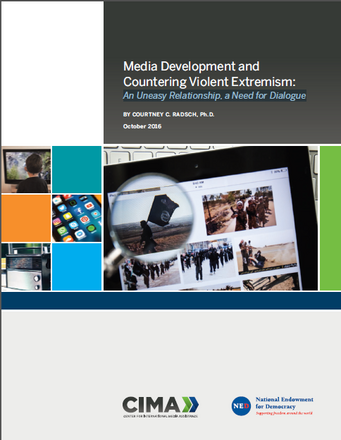
Media Development and Countering Violent Extremism
The term “Countering Violent Extremism,” or CVE, is now commonly used to refer to a variety of tactics and strategies—usually employing tools for mass communication—to counter the propaganda of violent extremism.
CVE strategy has gained prominence in the international agenda since 2015, along with the terrorist group ISIS, which has achieved unprecedented success in its use of social media to recruit new militants from around the world. CVE agencies have been established in the US and in the UK, while both USAID and OECD have included CVE among the activities funded through their resources.
The rise of the CVE agenda has been met quickly with controversy, as a significant number of the projects gathered under the CVE rubric involve media components and CVE agenda directly calls into question the strategic role of media and the guarantee of their independence.
CVE's prevention components, in particular, aims at countering propaganda and providing counter narratives, including content removal efforts. Thus far, such prevention has focused on countering ISIS and radical ideologies, although countering Russian propaganda and misinformation has become linked as well.
Media practitioners are thus debating the potential impact that the CVE agenda may exert on media development strategies. Media development practitioners are often non-governmental organizations that are wary of the security sector actors that are involved in CVE, such as the US Department of Homeland Security. The two fields also hold very different, perhaps incompatible, views. CVE pursues a strategic communication objective, whereas media development efforts focus instead on the quality of the media ecosystem as a goal.
Yet, the shared interest of both fields to find ways to respond to the spread of extremist views on digital media, poses the need for these two perspectives to enter in dialogue. This report provides a first step in that direction.
The report begins by examining the emergence of ISIS and its unique media strategy, which has been credited with spurring the group’s global reach. It then turns to the development of the CVE strategy and the various initiatives Western governments have undertaken to halt the spread of violent extremism, particularly in the media and online. With that foundation, the report then discusses the varied reactions to the CVE agenda from within the media development community, including the concerns felt by many media development practitioners that a focus on CVE may have unintended consequences when adopted by authoritarian regimes looking to censor oppositional media organizations. The report concludes by suggesting an agenda for dialogue and collaboration between the two sectors.
Tags: Propaganda Ethics of journalism WorldwideThe content of this article can be used according to the terms of Creative Commons: Attribution-NonCommercial 4.0 International (CC BY-NC 4.0) . To do so use the the wording "this article was originally published on the Resource Centre on Media Freedom in Europe" including a direct active link to the original article page.

